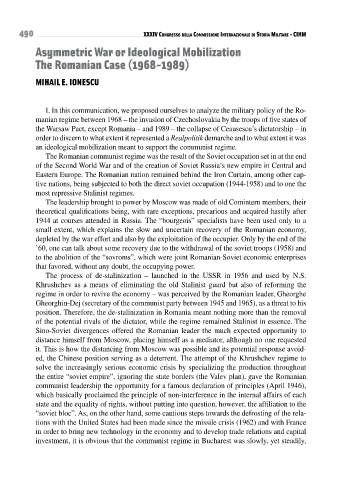Page 490 - Conflitti Militari e Popolazioni Civili - Tomo I
P. 490
490 XXXIV Congresso della CommIssIone InternazIonale dI storIa mIlItare • CIHm
Asymmetric War or Ideological Mobilization
The Romanian Case (1968-1989)
MIHAIL E. IONESCu
I. In this communication, we proposed ourselves to analyze the military policy of the Ro-
manian regime between 1968 – the invasion of Czechoslovakia by the troops of five states of
the Warsaw Pact, except Romania – and 1989 – the collapse of Ceausescu’s dictatorship – in
order to discern to what extent it represented a Realpolitik demarche and to what extent it was
an ideological mobilization meant to support the communist regime.
The Romanian communist regime was the result of the Soviet occupation set in at the end
of the Second World War and of the creation of Soviet Russia’s new empire in Central and
eastern europe. the Romanian nation remained behind the iron Curtain, among other cap-
tive nations, being subjected to both the direct soviet occupation (1944-1958) and to one the
most repressive Stalinist regimes.
The leadership brought to power by Moscow was made of old Comintern members, their
theoretical qualifications being, with rare exceptions, precarious and acquired hastily after
1944 at courses attended in Russia. The “bourgeois” specialists have been used only to a
small extent, which explains the slow and uncertain recovery of the Romanian economy,
depleted by the war effort and also by the exploitation of the occupier. Only by the end of the
’60, one can talk about some recovery due to the withdrawal of the soviet troops (1958) and
to the abolition of the “sovroms”, which were joint Romanian-Soviet economic enterprises
that favored, without any doubt, the occupying power.
The process of de-stalinization – launched in the USSR in 1956 and used by N.S.
Khrushchev as a means of eliminating the old Stalinist guard but also of reforming the
regime in order to revive the economy – was perceived by the Romanian leader, Gheorghe
Gheorghiu-Dej (secretary of the communist party between 1945 and 1965), as a threat to his
position. Therefore, the de-stalinization in Romania meant nothing more than the removal
of the potential rivals of the dictator, while the regime remained Stalinist in essence. The
Sino-Soviet divergences offered the Romanian leader the much expected opportunity to
distance himself from Moscow, placing himself as a mediator, although no one requested
it. This is how the distancing from Moscow was possible and its potential response avoid-
ed, the Chinese position serving as a deterrent. The attempt of the Khrushchev regime to
solve the increasingly serious economic crisis by specializing the production throughout
the entire “soviet empire”, ignoring the state borders (the Valev plan), gave the Romanian
communist leadership the opportunity for a famous declaration of principles (April 1946),
which basically proclaimed the principle of non-interference in the internal affairs of each
state and the equality of rights, without putting into question, however, the affiliation to the
“soviet bloc”. As, on the other hand, some cautious steps towards the defrosting of the rela-
tions with the United States had been made since the missile crisis (1962) and with France
in order to bring new technology in the economy and to develop trade relations and capital
investment, it is obvious that the communist regime in Bucharest was slowly, yet steadily,

